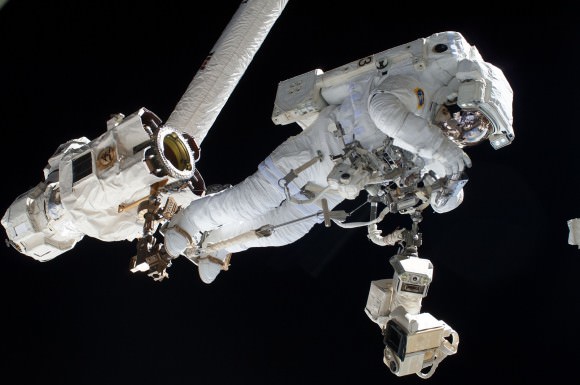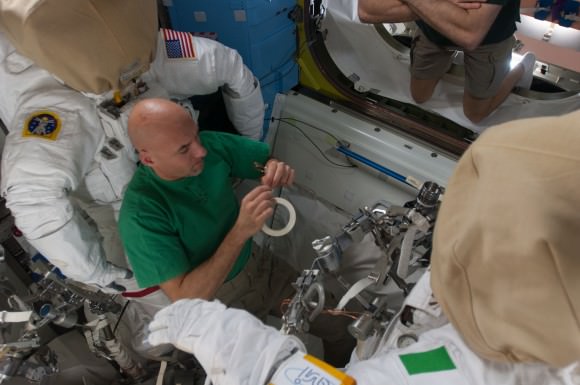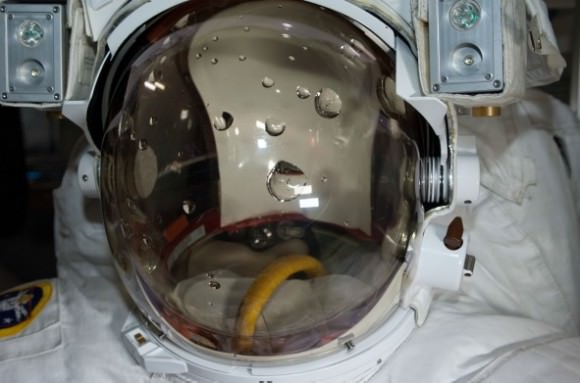While NASA’s Mission Control “performed admirably” during a spacewalk water leak crisis in July, a report on the incident showed that controllers did not send astronaut Luca Parmitano back to the airlock until after he made three calls saying the water didn’t appear to be from a drinking bag.
There are several reasons this happened, the mishap report says, such as inadequate training, the crew members and ground misunderstanding the severity of the situation, and a (false) perception that any water leak is likely due to a problem with the drinking bag.
Another big problem was the “normalization of deviance”, similar language to what was used during in reports describing the Challenger and Columbia incidents. In this case, small amounts of water in the helmet was expected, and controllers also misunderstood the cause of a carbon dioxide alarm (a fairly regular occurrence during spacewalks).
The report pulls no punches when it describes how bad things were: “The presence of this water created a condition that was life threatening.”
While talking about what is in the report, it’s also important to point out what the investigators did not find. There was no evidence that contractors were afraid to bring up problems (such as what happened during the 1986 Challenger explosion), chair Chris Hanson told reporters yesterday. Also, while the suits are 35 years old, no aging problem was detected.
Another couple of cautions: the report is preliminary (the exact cause of the leak is under investigation), it’s lengthy (222 pages) and much of the technical information is unavailable to the public due to export control restrictions. Any news story will just scratch the surface of what happened and the recommendations to fix it.
That said, here are a few key points we found in the report.

Parmitano warned controllers multiple times. The transcript shows three separate calls from Parmitano saying it wasn’t the drinking bag at cause: (1) “I feel a lot of water on the back of my head, but I don’t think it is from my bag.” (2) “The leak is not from the water bag and it is increasing.” (3) “I’m thinking that it might not be the water bag.” (In between 1 and 2, he also sent another call saying his “only guess” was it was the drinking bag, but the report adds that Parmitano may have softened his stance after speaking to controllers). Misunderstanding about the severity, lack of training, “cognitive overload” of controllers, and space-to-ground-to-space communication difficulties are all cited as contributing factors.
Drink bags don’t actually leak as much as people think they did. Unequivocally, the mishap investigation board says “the perception that drink bags leak, especially as a frequent occurrence, is false.” There has never been an instance of a bag leaking substantially during a spacewalk, the report says. After the crisis passed and investigators had the luxury of time, they in fact identified seven separate possible sources of water: (1) the bag; (2) the waste collection garment; (3) cooling water from the sublimator heat rejection component of the suit; (4) the Liquid Cooling Ventilation Garment connector or the tubing itself; (5) transfer lines through the Hard Upper Torso; (6) water storage tankage through the pressurizing bladders; (7) the water separator circuit (which is where the problem was eventually found).
It was a risky decision to send Parmitano back alone. Twenty-three minutes after Parmitano warned of water in his helmet, NASA terminated the spacewalk and as per procedure, had the astronaut head to the airlock while crewmate Chris Cassidy performed cleanup tasks before doing the same. (“Terminate” has a specific meaning as opposed to “abort”, which means both crew members leave immediately.) By this time, water was in Parmitano’s eyes and the station had passed into the shadow of the Earth, forcing him to feel his way back to the airlock along the tether. (This was only his second spacewalk on station, too.) Also, the water affected his communications equipment, as he made several calls “in the blind” that were not heard. At this time, Cassidy and the ground controllers did not know how severe the situation was. “Additional risk exposure that the team could have considered was the aspiration of water, failure of comm equipment, and impaired visibility,” the report said.

The emphasis on science on station can hinder with maintenance tasks. NASA and other space station partners are eager to demonstrate how great the station is to science, but crew time is divided between that and doing maintenance tasks. “Due to this knowledge, team members felt that requesting on-orbit time for anything non-science related was likely to be denied and therefore tended to assume their next course of action could not include on-orbit time,” the report states. To give a specific example of how this affected Parmitano’s suit: After water was found in the suit during a previous spacewalk, the crew and ground essentially determined it was due to the drink bag and did not probe further, partly because of the perception that doing an investigation would take an inordinate amount of time for little return (as they believed they knew the cause). On a related note, there was also the concern that investigating this occurrence (which happened on July 9) would delay the July 16 spacewalk. (Again, this sounds a bit like Challenger, where time pressure was cited as a reason to launch despite icy conditions.)
More needs to be done to understand the physics of water in a spacesuit. A few examples: it was believed the fan would have failed if water got through the separator unit, which did not occur. It was also believed that any water in the helmet would cling to the helmet, and not the crew member’s face. Not only that, the training for crew and ground was inadequate to seek out water causes on the fly. “Had this been done, the crew and ground team may not have attributed water in the helmet to just the drink bag,” the report stated.
Water in the helmet was normalized. If you’ve read Chris Hadfield’s An Astronaut’s Guide to Life On Earth, there’s an account in there about how Hadfield (who also was a junior spacewalker in 2001) became temporarily blind due to an anti-fog agent on the helmet getting into his eyes. This has happened during other spacewalks, too, which meant that the ground team was used to small amounts of water in the helmet — even though this wasn’t a normal condition. Another aspect: a carbon dioxide alarm went off in Parmitano’s suit after it became saturated with water. This happened six minutes before he felt the dampness. The team attributed this to “nominal accumulation of moisture in the vent loop,” which can happen at the end of the spacewalk. Having it happen less than an hour in, however, did not trigger a fault-finding process.

While there are many, many causes in the report (with aspects ranging from the technical to the procedural to the training), members identified three main ones to the incident: (1) inorganic materials in the water separator drum holes, for reasons still unknown (2) a lack of understanding that meant the team’s response took longer than usual (3) a misdiagnosis of the water found during the July 9, 2013 spacewalk.
There are 49 separate recommendations ranging from “Level 1” priority to “Level 3”, which are still important but less urgent. NASA has pledged it will clear all “Level 1” and “Level 2” items before doing any normal spacewalks, although contingency ones are still possible. They expect this to be finished by June, but say they will take as long as needed to get the investigation done. There are no pressing spacewalk tasks on station right now.
Looking to the long run, the report noted that there should be more backups available if a fault is found in the spacesuits, as NASA is relying on these devices to perform essential station maintenance as far as 2028. Also, the investigators say that the six-year certification of these suits for orbital tasks is likely inadequate, and calls for a review of that. So although aging was not identified as an issue, maintenance and backups of the spacesuits could be key features of NASA thinking in the months and years to come.


Caption for the 2nd photo reads: “European Space Agency astronaut Luca Parmitano on a spacewalk July 9, 2016…” Date should read “July 9, 2013.”
Fixed, thanks.
A lengthy and very detailed investigation. But the return in this will be on any future spacewalk and spacesuit maintenance check.
YOLO just doesn’t apply if you want to get out in space.
Another example of bureaucracy gone mad.
Did it occur to the astronaut, ground controllers or anyone else that the astronaut could have removed enough of the water a very novel approach:
** have a drink **
???
I guess in fairness what i dont know is if the water could have had coolant toxins – i still wonder if a few big gulps may have been an option
This was a close call, we tend to think space is nice and easy because of all the success in the I.S S. we are only learning and have a long way to go before it is even remotely safe in space ,we are just small children learning to walk……